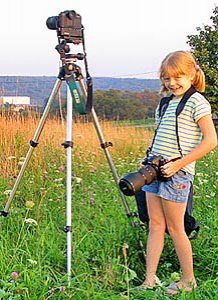CAS,
It really depends largely on your budget. You could blow the better part of a grand on a super DSLR outfit, but if all you're looking for is shots to print in 4x6 or post to the web, it's money out the window. And if you're not a photographer to begin with, you'd be paying for a lot of features you're never going to use. From what you describe, you are looking for a small point-and-shoot camera.
Ken Rockwell is a professional photographer with an attitude, and he leans towards common sense. His
Digtal Camera page might be a good place to start. I especially like his
"A $150 versus a $5,000 camera" comparison. It really points up how easy it is to get caught up in photo gear, and thinking bigger/more is better, and why it's not necessarily so.
Having gone through all this recently, I decided that while I'd really like a DSLR (since I have a ton of lenses I could use on one), I can't really justify the price of a body compared to the results I'd get from a smaller all-in-one. Right now, about the only advantage that DSLRs have for me is that in lower light they perform better because they have a larger sensor (CCD), that produces crisp images with less noise than the smaller CCD's used in the point-and-shoots, and for the shooting I'm doing, that's not a big enough issue to justify the extra $$$.
If you're impressed with DoctorWayne's pics, note that he shoots them with a Kodak point-and-shoot, and I don't think anyone will argue that his results look very good. He describes his technique in
this post.
Look for something with at least 3x optical zoom, a macro mode, and 4-6 megapixels should do you fine. I was shooting a Fuji FinePix S3100 that I picked up for $125 - 4 megapixels, 6x optical zoom a decent macro mode, and some manual control over exposure.
These pics were shot with it.
I wanted a bit more (ok, a lot more!

) manual control, so I waited until I found a Fuji S9000 factory refurb at the price I wanted.
I shot these pics with it.
Apart from the better exposure (which I also learned how to control with the S3100), I doubt you'll see much difference between these and the other pics. The reason is that you have to shrink your pics to a fraction of their original size for posting on the web, and so a lot of detail in higher megapixel images gets lost anyways.
For what you're looking to do, invest in a decent tripod, and a 4-6 MP camera with a decent lens (3-6x optical zoom and macro capability of less than a foot to ~3'). In the $200 price range there's lots to choose from, and most of them are pretty decent.
There's a ton of info on the web, and it's easy to get overwhelmed, especially if you go to someplace like
dpreview.com , where they review hundreds of cameras.
Rather than get caught up in all the technical mumbo-jumbo, cut to the end, look to see if the pro's outweigh the con's, and check the overall rating.








